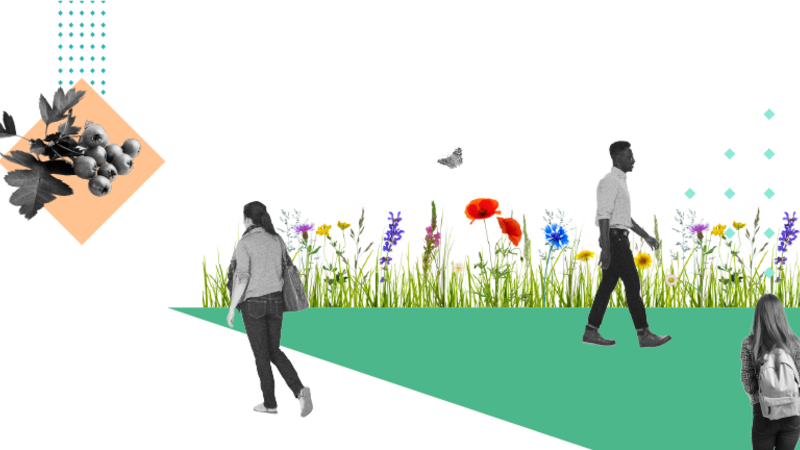Biodiversity progress
Overview
Biodiversity changes occur over the long term, making short-term progress challenging to report in measurable terms. To address this, we're currently taking a narrative approach to biodiversity reporting to capture our progress and efforts, emphasising actions taken, outcomes, and long-term trends.

Summary
We have made progress towards delivering our Biodiversity Action Plan (BAP) during 2023-24.
- We have employed our first dedicated Biodiversity Manager.
- We have stopped using external contractors for operational city site grounds work by bringing work 'in-house'.
- To support the management of our sites with biodiversity considerations we have increased the size of our Estates Division (ED) operational grounds team, while providing advice, training and support. This includes delivery of grasslands-focused grounds maintenance training coordinated with the Wildlife Trust for Bedfordshire, Cambridgeshire & Northamptonshire. Recipients of this training include our ED operational grounds team, city grounds team, and some Cambridge College gardeners.
- We have bought equipment (electric instead of diesel operated, where possible) to support the management of our grounds whilst considering biodiversity. For example, we purchased a machine better capable of dealing with cutting longer swards (stretches of grass) or annual cuts of wildflowers.
- We have prioritised the management of lines of trees at Cambridge University Park Farm. During 2023-24, we secured consent tocoppice800m of overmature (overgrown) crack willows growing alongside a ditch. This work has now been completed in 2024-25.
- We have improved the quality of grassland at Madingley Park (part of the University Park Farm and Rural Estate) in line with our Countryside Stewardship Higher tier Agreement. We have also commissioned a report from the Wildlife Trust for advice on achieving increased diversity among plant species within grassland.
- We have reviewed management intervention to selectively thin dying and dead standing trees. Ash dieback and sooty bark disease led to necessary regeneration fells of several areas of University-owned woodland. Statutory consents were secured during 2023-24, as well as a tree health grant to partially fund restocking of trees.
- We have considered options for tree restocking. During 2023-24, the tree restocking species mix was agreed with the Forestry Commission as part of the tree health grant. 75% of tree species have been predetermined, leaving 25% flexibility in the tree species that can be planted. We are arranging a meeting with researchers using Madingley Wood to seek their views on refining the mix, and the detail of restocking and future management in spring 2025. In autumn 2025, we aim to restock the sections of woodland that were felled during winter 2024.
- We have increased the quality and extent of aquatic habitats. For example, asilted up pond at Park Farm was dredged and cleared of shading trees and scrub.
- We areintegrating our mapping, monitoring and recording in a way that works for nature on a landscape scale, whilst considering wider landholders (including Cambridge Colleges).
- We are making sure we comply with mandatory Biodiversity Net Gain (BNG) requirements in a way that benefits nature as much as possible.This work is led by Head of Estate Strategy and Planning, with support from our Rural Surveyor, from Bidwells, and with expert advisory capacity from our Biodiversity Manager.
The Environmental Sustainability Team also continues to provide specialist ecological advice to the University and colleagues for major development projects including Cambridge West, Eddington and Reshaping our Estate, including reviews of maintenance contracts for our existing network of green roofs to ensure best outcomes for biodiversity.
Next steps
We are planning to carry out ecological surveys during spring/summer of 2025 to assess our progress against the targets laid out on page 26 of our BAP.Habitat surveys will be carried out at sites on our urban and rural estate where quantitative targets for biodiversity enhancement or protection have been set. The surveys will assess habitat condition against standard metrics (UKHab) depending on habitat type. We plan to survey grasslands, scrubland, hedgerows, and lines of trees.
We are also partnering with the Wildlife Trust to assess two county wildlife sites under our management. This will allow us to see how our management practices have been working and determine if we need to change anything.
These surveys will be the first round of biodiversity monitoring since our initial surveying in 2017-18. Woodlands will be resurveyed at a later date.
Additional and historic data
For our commitments and approach, please visit the Biodiversity page.
All previous Annual Environmental Sustainability Reports and carbon emissions reports are available up to 2022-23. Our reporting approach changed from the 2023-24 year onwards to Our progress pages to make information more transparent and accessible. Qualitative progress against our commitments can be found within our Case studies. These will both be updated on an ongoing basis as new data and material becomes available.
You can also read about the University's work on environmental sustainability in its Annual Report and Financial Statements. Further operational environmental sustainability information is available on request using sustainability@admin.cam.ac.uk
